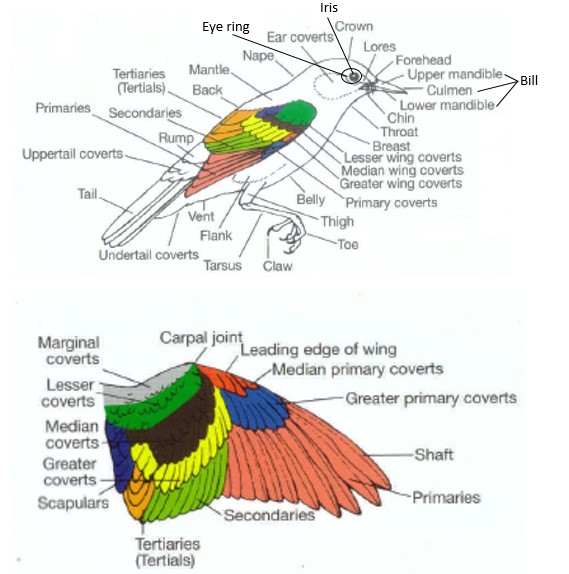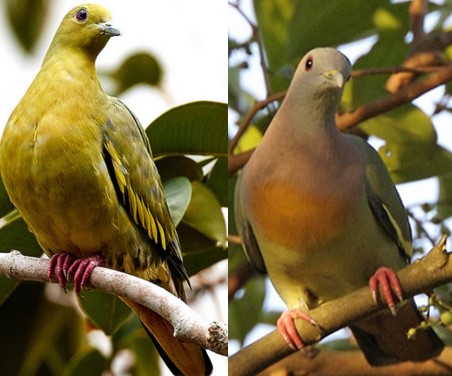
Female (left) and Male (right) Pink-necked Green Pigeon Photos by Melvin Yap (left) and Yap Lip Kee (right). Creative Commons License.
Table of Contents
Introduction
Do you know that the Pink-necked Green Pigeon is even more common than house crow and common pigeon in Singapore? According to the 30th Annual Bird Census conducted by the Nature Society (Singapore) in March 2015, the Pink-necked Green Pigeon is ranked the 3rd most common bird, after Javan Myna and Asian Glossy Starling. The pink-necked green pigeon is the most common green pigeon in Singapore, with populations distributed across Southeast Asia, Thai-Malay Peninsula and Greater Sundas east to Philippines, Sulawesi and Maluku.[1] You may wonder why you do not see this bird more frequently as you should since it is apparently so common. Pink-necked Green Pigeons are arboreal (tree-dwelling)[2], and hence to be able to spot this bird, you have to stop looking at the ground and instead look up to the trees! Also, this bird is able to produce milk, read on to find out how it is produced!
Description and Identification
Descriptions and identifications are based on Yong et al. (2013)[1], Robson (2015)[3] and Jeyarajasingam & Pearson.[4]
The general bird anatomy, as well as the coloured wing anatomy are shown below for easy visualisation and understanding of the jargon used in the description sections.
General bird anatomy and wing anatomy (coloured), adapted from from Phillips' Field Guide to the Birds of Borneo (2009).[5]
Adult
In general, the Pink-necked Green Pigeon is medium sized ranging from 26.5 to 32 cm with pale green bill. (Click here for description and function of a bill) This pigeon has chestnut undertail coverts, pale green wings, black flight feathers and black subterminal (located at near end) tail bands. Sexual dimorphism is present in this species in which the male does not look like the female. Males have bluish grey heads (crown), pinkish napes and upper breasts (hence the common name!) as well as orange lower breasts in addition to a green plumage while the females have a uniformed green plumage. The comparison of morphology (external appearance) of male and female Pink-necked Green Pigeon is shown below.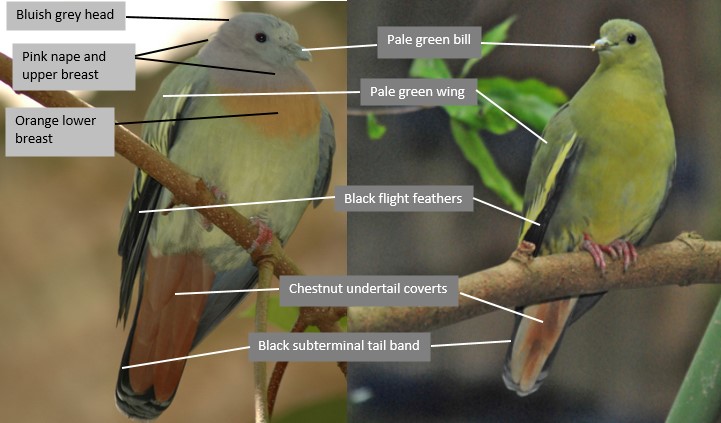
Distinctive features of male (left) and female (right) Pink-necked Green Pigeon with white text indicating common traits in both sexes and black text indicating traits unique to males. Original photos by Kevin (left and right), Creative Commons License.
Juvenile
Juveniles have similar morphological characteristics as females except that they have browner primaries tips and tertials.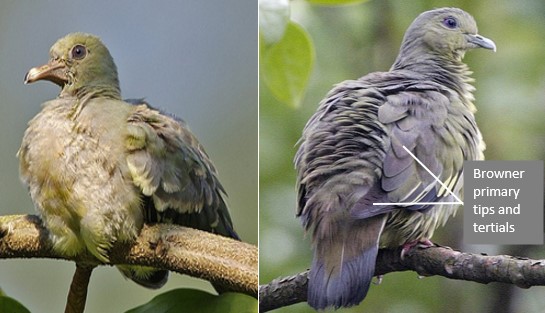
Juvenile Pink-necked Green Pigeon. Photo by Yap Lip Kee (Creative Commons License).
[Back to top]
Diagnosis from other Green Pigeons
Based on the descriptions by Yong et al. (2013)[1] and Robson (2015).[3]
Although the Pink-necked Green Pigeon is very common, identification of the Pink-necked Green Pigeon can be confused with the other more uncommon green pigeons such as Little Green Pigeon (Treron olax) and Thick-billed Green Pigeon (Treron curvirostra) especially for the females. According to the annotated checklist of the birds of Singapore (2007) , Little Green Pigeon is a rare resident and the Thick-billed Green Pigeon is an uncommon resident breeder.[6]
The distinct features present in both sexes of Thick-billed Green Pigeon and Little Green Pigeon which differentiate them from the pink-necked green are shown in the figure and table below. The Little Green Pigeon has a bluish bill at base with pale iris, the Pink-necked Green Pigeon has a pale green bill with black iris and the Thick-billed Green Pigeon has a thick pale green bill with a red base and greenish-blue eye ring.

Comparison of differences of Little Green Pigeon, Pink-necked Green Pigeon and Thick-billed Green Pigeon. Differences are present in both sexes.
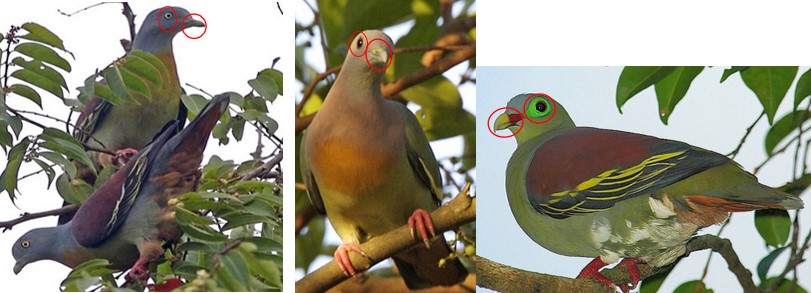

Female Little Green Pigeon (left), Pink-necked Green Pigeon (middle) and Thick-billed Green Pigeon (right).Distinct features of Little Green Pigeon and Thick-billed Green Pigeon present in both sexes are circled in red.Photos by Kevin (middle), Creative Commons License, Patrice Correia (right) and Jason Lee (left), permission granted. Permission pending for the photo by Patrice.
[Back to top]
Vocalisations
Pink-Necked Green Pigeons are not very vocal and they vocalise more frequently during mornings and evenings at communal roosts. [7]
The call of Pink-Necked Green Pigeon is a series of gurgling warbles followed by harsh grating and finally end in two raspy notes of krrak krrak.[1][3] Listen to the vocalisation of the Pink-necked Green Pigeon from xeno-canto below.
Biology
Habitat
Pink-Necked Green Pigeons are the only green pigeons which are found outside of primary forests. They are arboreal and occupy a wide range of terrestrial habitats such as secondary forests, mangroves, parks and even in urban greenery such as the trees lining along Orchard Road! They do not migrate and are relatively sedentary.[1][8]Social behaviour
Being gregarious birds, Pink-necked Green Pigeons roost in flocks of 5-50 in early mornings and evenings.They tend to roost in tall trees in swamps and mangrove forests.[4][9] In urban areas, the pigeons have been sighted roosting in trees such as Golden Penda (Xanthostemon chrysanthus) that have dense crowns and located away from roads.[24]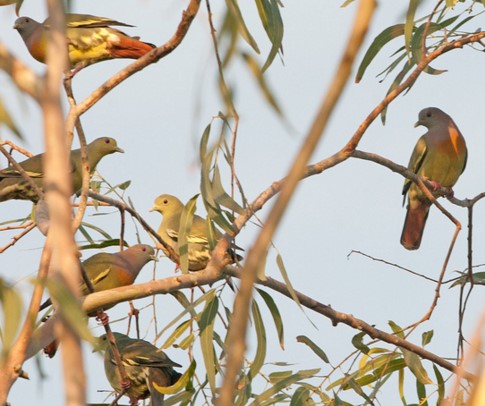
Foraging and Feeding
Foraging is done most actively in the early morning at fruiting trees. The frugivorous Pink-necked Green Pigeon feeds on syconia of Weeping Fig (Ficus benjamina) and Singapore Cherry (Muntingia calabura). Being frugivores, they aid in seed dispersal as well.[9]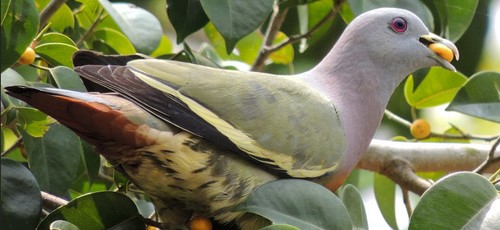
Reproductive cycle
The breeding season of the Pink-necked Green Pigeon occurs during late March to late July. Pink-necked Green Pigeons display a monogamous breeding relationship in which in observed in 90% of bird species. Both sexes are involved in nest building, egg incubation and chick brooding.[26] For more information about monogamy, please click here.Nesting
Nesting is done in a pair and not in groups. Both male and female help in the construction of the nest in which the male looks for nesting materials while the female does the construction of the nest itself [8] (Watch the video of nest construction below). The completed nest is about 15-20 cm in diameter and it is mostly made up of twigs, typical of a pigeon nest. The nests are so thin that the contents can be seen from below! [1] It has also been reported that Pink-necked Green Pigeons are seen nesting in abandoned nests of Scaly-breasted Munia (Lonchura punctulata).[25]Egg Incubation
The female lays a clutch of 2 white eggs and both sexes help in incubation of the eggs. The male incubates the eggs during daylight hours till about 5pm and the female takes over and incubates the eggs till about 8am. Incubation takes about 17 days and takes 10 days before the chicks are fledged. Fledglings may remain near their nests for about a week.[9][10]Watch the video of egg incubation below and be prepared for an unexpected twist! Do note that the sex was mixed up in the earlier part of the video.
Crop milk
Before fledging, the nestlings were fed crop milk from their parents. Crop milk is only produced in doves and pigeons. It is produced by a “sloughing of fluid-filled cells from the lining of the crop”, which is a food storage gland located at the bottom of the oesophagus. The chicks are able to drink the crop milk by poking their bills down their parents’ throats. Crop milk is highly nutritious and it contains more proteins and fats than cow or human milk.[11] The ability to produce crop milk means that the parents do not have to actively forage for food and expose their chick(s) to predators. As production of crop milk is gradual and requires time, this may explain the fact that only a maximum of 2 eggs were produced during each time to ensure that the sufficient amount crop milk is available for each chick.[8] After fledging, the fledglings are fed with a mixture of crop milk and regurgitated food. Watch the video below to watch the feeding of crop milk and regurgitated food.[Back to top]
Distribution and range
Pink-Necked Green Pigeon has a wide distribution size (breeding/resident) of 2,260,000 km2, and is a native resident in most countries in South East Asia.[12]

Singapore
Being the most common green pigeon in Singapore, the Pink-Necked Green Pigeon can be easily located in major parks such as Bishan-Ang Mo Kio Park, Kent Ridge Park and nature reserves (Sungei Buloh Wetland Reserve and Labrador Nature Reserve) in Singapore. There are sightings of this pigeon even at offshore islands such as Tekong Island, St John’s Island and Pulau Semakau. Check out the map of the local sightings of Pink-necked Green Pigeon. You can even mark out your Pink-necked Green Pigeon by clicking here!Local sightings of Pink-necked Green Pigeon. Green markers refer to sightings in nature reserves, yellow for parks and red for sightings in offshore islands.Map data adapted from Digital Nature Archive of Singapore
[Back to top]
Conservation status
The Pink-Necked Green Pigeon was categorised as Least Concern in International Union for Conservation of Nature and Natural Resources (IUCN) Red List of Threatened Species Assessment in 2012, probably as a result of its large range.[13] For more details of the justification of the IUCN conservation status of Pink-necked Green Pigeon, please click here
Taxonomy and systematics
Taxonavigation
Kingdom: AnimaliaPhylum: Chordata
Class: Aves
Order: Columbiformes
Family: Columbidae
Genus: Treron
Species: Treron vernans
Source: ITIS [23]
Do note that the rankings are purely arbitrary and the ranks do not tell us anything about the organisms in a specific group. Instead, phylogenetics are used, which study the evolutionary relationships among clades and organisms.
There are at least 8 “subspecies” [14] of Treron vernans described but these names are considered invalid as these subspecies are not included in major checklists in Integrated Taxonomic Information System (ITIS) [15] and eBird/Clements Checklist of birds of the world.[16]
Original description
The species was originally described under the name of Columba vernans by Carl Linnaeus in 1771 in page 526 of Mantissa Plantarum Altera Generum editionis specierum editionis II & VI. Holmiae. The original description was in Latin which roughly translates to 'green dove with yellowish exterior wing margins'.
Louis Jean Pierre Vieillot described the genus Treron in 1816 and from then on, the Pink-necked Green Pigeon was renamed as Treron vernans.[17]
Etymology
The common name of Treron vernans is named as such due to the pink napes and upper breast (neck) in males and the overall green plumage seen in both sexes. Linnaeus gave the initial name of the genus Columba, which was Latin for dove.In ornithology , the term “pigeon” is generally used to describe birds with a plump body form while the term “dove” is used for birds with a smaller body form, but both terms are now considered synonymous and can be used interchangeably.[18]
Type Specimen
Unfortunately, the type specimen for Treron vernans could not be found online. The type information about the "subspecies" Treron vernans vernans is shown below. The type specimen of "Treron vernans vernans" is located at the Smithsonian Institution National Museum of Natural History, in Division of Birds under the Department of Vertebrate Zoology. Do note that subspecies of the Pink-necked Green Pigeon are invalid and that the species (Treron vernans) is monotypic.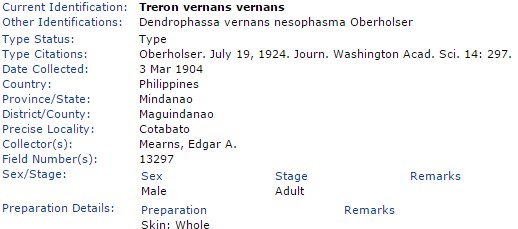
Phylogeny
The oldest Columbiformes fossil was Gerandia calcaria (extinct) from the Early Miocene in France, dated between 20.4 and 23.0 million years ago, suggesting that pigeons emerged between 20.4 and 23 million years ago.[19] It has been estimated that a temporal gap of 41 to 46 million years between the origin of Columbiformes in the Late Cretaceous and diversification of genera within the order in the Eocene.[20]The placement of pigeons and doves (Columbiformes) is shown below in the avian tree constructed by Jarvis et al. in 2014.[21] Phylogenetic trees can be constructed using different methods (maximum likelihood, maximum parsimony, etc) and different DNA barcodes are used. From the tree, we can deduce that pigeons belong to the neoaves clade which consists of all modern birds and that the next closest related clades to the pigeon are probably sandgrouse and mesites. The very high bootstrap values (100%) suggest that these relationships are strong and are unlikely to change. For more information about bootstrap, please click here.
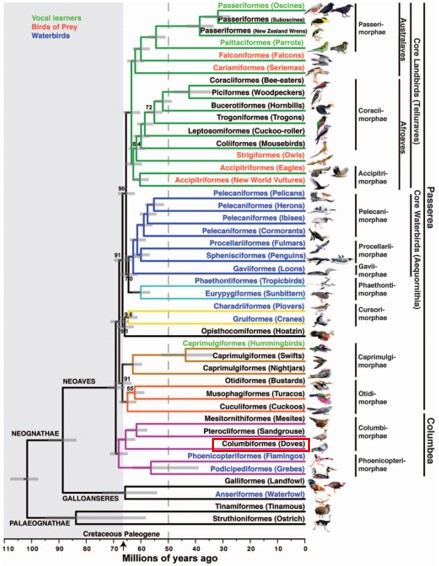
The relationship of Treron vernans with fruits doves (Ptilinopus sp.) in Columbidae is shown below in the phylogenetic tree generated by Cibois et al. (2014) [22]using maximum likelihood and Bayesian inference. The DNA barcodes used were mitochondria genes NADH dehydrogenase subunit 2 (ND2), cytochrome c oxidase subunit 1 (COI) and NADH dehydrogenase subunit 3 (ND3) as well as using nuclear genes beta-fibrinogen (FGB) and recombination activating gene 1 (RAG1). It can be deduced that Treron vernans is an outgroup and is highly distinct from fruit doves. The clade containing imperial pigeons (Ducula sp) shared a relatively ancient last common last ancestor with the fruit doves before splitting into two clades.However, given the relatively low bootstrap values (<70%), it is highly unlikely that the relationship is supported. Jambu fruit dove (Ptilinopus jambu) which is the only fruit dove in Singapore is related most closely to Ptilinopus leclancheri.
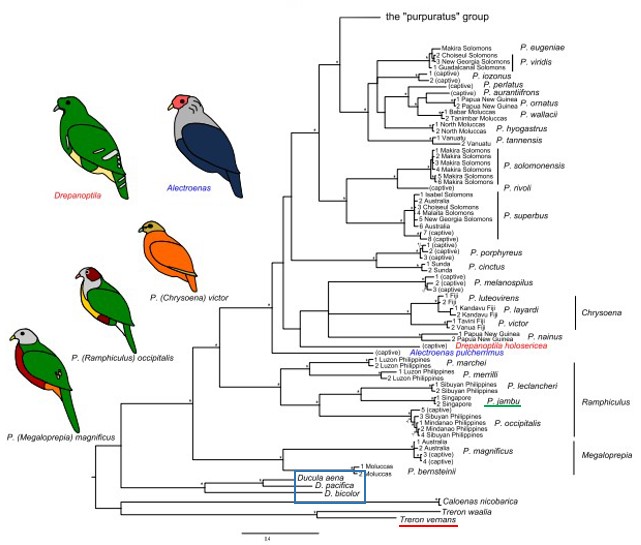
Phylogenetic tree based on nuclear and mitochondrial genes and using maximum likelihood and Bayesian inference analyses generated by Cibois et al., 2014. Asterisks indicate indicate nodes supported by posterior probabilities ≥0.95 and bootstrap values ≥70%.
Barcode data
Barcode data of Treron vernans can be found here, below is a summary of the different type of records of Treron vernans.
[Back to top]
References
1. Yong, D.L., Lim, K.C., & Lim, T.K., 2013. A naturalist's guide to the birds of Singapore. United Kingdom: John Beaufoy publishing.2. Strange, M., 2014. A photographic Guide to the Birds of Southeast Asia. Tuttle Publishing.
3. Robson,C., 2015. Birds of South-East Asia: Concise Edition. [online] Available from: https://books.google.com.sg/books?id=Ew50CQAAQBAJ . Accessed 11 November 2015.
4. Jeyarajasingam, A. & Pearson, A., 2012. A Field Guide to the Birds of Peninsular Malaysia and Singapore. Oxford University Press.
5. Phillips, Q. & Phillips, K., 2009. Phillips's Field Guide to the Birds of Borneo. John Beaufoy publishing.
6. Wang, L.K. & Hails, C. (2007). An annotated checklist of the birds of Singapore. Raffles Bulletin of Zoology Supplement 15.
7. Baptista, L.F., Trail, P.W., Horblit, H.M. & Kirwan, G.M. (2013). Pink-necked Green-pigeon (Treron vernans). In: del Hoyo, J., Elliott, A., Sargatal, J., Christie, D.A. & de Juana, E. (eds.) (2013). Handbook of the Birds of the World Alive. Lynx Edicions, Barcelona. Retrieved from http://www.hbw.com/node/54288. Accessed:11 November 2015.
8. Tan, R,. 2001. Pink-necked Green Pigeon. [online] Available from: http://www.naturia.per.sg/buloh/birds/Treron_vernans.htm. Accessed 11 November 2015.
9. Lee Kong Chian Natural History Museum, 2015. Treron vernans. [online] Available from: http://lkcnhm.nus.edu.sg/dna/organisms/details/464. Accessed 11 November 2015.
10. Seow, G., 2007. Nesting Exploits of the Pink-necked Green Pigeon. [online] Available from: http://gloriousbirds.blogspot.sg/2007/01/nesting-exploits-of-pink-necked-green.html. Accessed 11 November 2015.
11. Ehrlich, P. R., Dobkin, D. S., and Wheye, D., 1988. Bird Milk. [online] Available from: https://web.stanford.edu/group/stanfordbirds/text/essays/Bird_Milk.html. Accessed 11 November 2015
12. BirdLife International (2015) Species factsheet: Treron vernans. [online] Available from: http://www.birdlife.org/datazone/speciesfactsheet.php?id=2633. Accessed 11 November 2015.
13 BirdLife International, 2012. Treron vernans. The IUCN Red List of Threatened Species 2012. [online] Available from:http://www.iucnredlist.org/details/22691137/0. Accessed 11 November 2015.
14. Morlan, J., 2013. [online] Available from: http://fog.ccsf.cc.ca.us/~jmorlan/Thailand/Pink-neckedGreenPigeonP1070623.htm. Accessed 11 November 2015.
15. Integrated Taxonomic Information System, n.d. Treron vernans (Linnaeus, 1771). [online] Available from: http://www.itis.gov/servlet/SingleRpt/SingleRpt?search_topic=TSN&search_value=177304. Accessed 11 November 2015.
16. Clements, J. F., Schulenberg,T. S., Iliff, M. J., Roberson, D., Fredericks, T. A., Sullivan, B. L,. and Wood,C. L.,2015. The eBird/Clements checklist of birds of the world: v2015. Downloaded from http://www.birds.cornell.edu/clementschecklist/download/
17. Lepage, D., 2003. Treron-Avibase. [online] Available from: http://avibase.bsc-eoc.org/species.jsp?avibaseid=71579DD974FD0311. Accessed 11 November 2015.
18. Baker,N., n.d. Pigeons and Doves. [online] Available at http://www.ecologyasia.com/verts/birds/pigeons.htm. Accessed: 11 November 2015.
19. Olson, S. L., 1985. The fossil record of birds. Academic Press, New York.
20. Pereira, S. L., Johnson, K. P., Clayton, D. H., & Baker, A. J. (2007). Mitochondrial and nuclear DNA sequences support a Cretaceous origin of Columbiformes and a dispersal-driven radiation in the Paleogene. Systematic Biology, 56(4), 656-672.
21. Jarvis, E. D., et al., 2014 Whole-genome analyses resolve early branches in the tree of life of modern birds. Science 346.6215: 1320-1331.
22. Cibois, A., Thibault, J. C., Bonillo, C., Filardi, C. E., Watling, D., & Pasquet, E., 2014. Phylogeny and biogeography of the fruit doves (Aves: Columbidae).Molecular phylogenetics and evolution, 70, 442-453.
23. Integrated Taxonomic Information System, n.d. Treron vernans (Linnaeus, 1771). [online] Available from:
http://www.itis.gov/servlet/SingleRpt/SingleRpt?search_topic=TSN&search_value=177304. Accessed: 27 November 2015.
24. Wee, Y. C., 2014. Why do some birds roost in trees but not others? [online] Available from: http://www.besgroup.org/2014/09/25/why-do-birds-roost-in-some-trees-but-not-others/. Accessed 27 November 2015.
25. Lim, M. & Lee, C. S., 2014. Pink-necked Green Pigeon uses abandoned munia's nest. [online] Available from: http://www.besgroup.org/2014/08/14/pink-necked-green-pigeon-uses-abandoned-munia%E2%80%99s-nest/. Accessed 27 November 2015.
26.Wee, Y. C. & Wee, J., 2013. Sex and the birds: 2 mating systems. [online] Available from: http://www.besgroup.org/2013/10/26/sex-and-the-birds-2-mating-systems/. Accessed: 27 November 2015.
